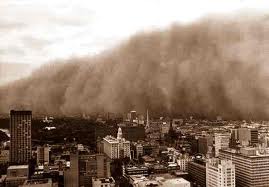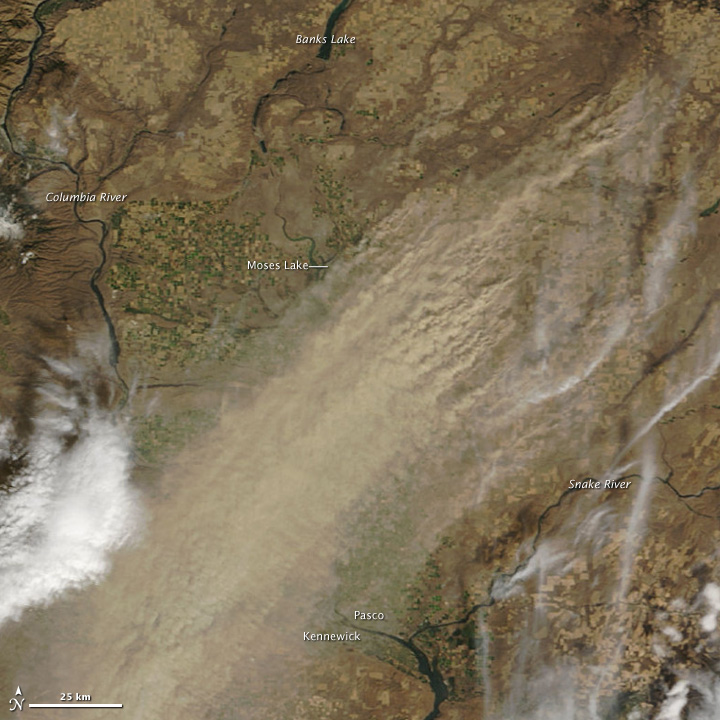Exceptional Events
As we are all aware, Benton County is occasionally subject to wind and dust storms. These storms can cause the PM concentrations in the air to become unhealthy, and to exceed the National Ambient Air Quality Standards. Along with Ecology, EPA and WSU, research has been done and agricultural and other practices implemented in the last several years so that the dust storm frequency has decreased since the early 90s.
Dust storms can still happen, however, and the BCAA reacts to them according to the Natural Events Action Plan 2003 described below.
Here is a satellite photo of an event that affected our area in
BCAA must provide public notice should ambient PM levels begin to reach health-impact thresholds during a high wind event. BCAA must also gather meteorological and other data and provide event documentation to the EPA.
This action policy, and the documentation is important for two reasons:
Protection of public health is a central part of the mission of the Clean Air Act and BCAA.
If any area exceeds pollution concentrations defined by the National Ambient Air Quality Standards, or NAAQS. more frequently than is permitted by the rule, the area is put into “non attainment”. The non attainment status has significant planning and possibly economic impacts to that area. Since the policy does require that dust originating from man-made sources be controlled according to a best practice, documenting that essentially “nothing more could have been done” to prevent the exceedance avoids a determination of non attainment.
Introduction
During the late 1980s and early 1990s a large number of exceedance of the 24-hour National Ambient Air Quality Standard (NAAQS) form particulate matter ten microns or less (PM10) were recorded in Spokane, Kennewick, and Wallula, Washington. An examination showed a close correlation to high wind events. The exeedances are primarily attributable to activity on agricultural fields, although other sources may contribute.
The Columbia Plateau is subject to frequent high winds, particularly during the spring, summer and fall. The Columbia Plateau has a winter precipitation pattern. Topography plays a role since the area closest to the Cascade Mountains has a very low annual rainfall. Low rainfall along with high temperatures causes the soil moisture to evaporate far faster than incoming rain.
The type of soil also plays a part. The Columbia Plateau soils are silty to fine and sandy and have a very weak soil structure. Once it is broken down by tillage, planting, or traffic, it will not form or re-form clods and is very susceptible to wind erosion. This erosion can be worse when the soil has no surface cover, and has been mechanically disturbed.
The Columbia Plateau PM10 Project
 Information about the Columbia Plateau PM10 Project is here. The Columbia Plateau is a 50,000 square mile region in Washington, Oregon, and Idaho containing both one of the driest as well as the most productive rainfed wheat regions in the world. Windblown dust is a concern in the dryer regions of the Columbia Plateau; dust generated from farming and construction sites poses a hazard to motorists, reduces soil productivity, and pollutes air in downwind communities.
Information about the Columbia Plateau PM10 Project is here. The Columbia Plateau is a 50,000 square mile region in Washington, Oregon, and Idaho containing both one of the driest as well as the most productive rainfed wheat regions in the world. Windblown dust is a concern in the dryer regions of the Columbia Plateau; dust generated from farming and construction sites poses a hazard to motorists, reduces soil productivity, and pollutes air in downwind communities.
Since 1993, a multi-disciplinary team of scientists has worked to provide significant insight and quantification on wind erosion and dust emissions from farm fields and the potential impacts to people living downwind. We have tested and verified a number of potential farm management and cropping system options to control wind erosion. Our field research has shown that some control practices are clearly not agronomically and economically viable, whereas other practices can be put to use to benefit our soil resource and air quality without hardship to the livelihood of farmers. The project continues to identify or develop sustainable practices that will reduce dust emissions from agricultural soils as well as to develop the capabilities to predict blowing dust events. As a result, decisions by farmers and agencies are being made from solid science.
The work of the Columbia Plateau Project has supported and continues to inform efforts to minimize windblown dust in Benton County.
Description of the EPA’s Exceptional Events Policy
The policy addresses PM-10 National Ambient Air Quality (NAAQS) violations caused by natural events. In the Columbia Basin these exceedances are caused by high wind.
This policy applies at the time the State determines that a PM-10 NAAQS has been violated due to natural events and addresses the question of what should be done to protect public health.
The guiding principles followed in developing this policy are:
1. Protection of public health is the highest priority of Federal, State, and local air pollution control agencies.
2. The public must be informed whenever the air quality in an area is unhealthy
3. All valid ambient air quality data should be submitted to the EPA Aerometric Information Retrieval System (AIRS) and made available for public access.
4. State and local agencies must take appropriate reasonable measures to safeguard public health regardless of the source of PM-10 emissions.
5. Emission controls should be applied to sources that contribute to exceedances of the PM-10 NAAQS when those controls will result in fewer violations of the standards.
Definition of PM-10 Natural Events caused by High Wind High Winds:
 Ambient PM-10 concentrations due to dust raised by unusually high winds will be treated as due to uncontrollable natural events under the following conditions:
Ambient PM-10 concentrations due to dust raised by unusually high winds will be treated as due to uncontrollable natural events under the following conditions:
(1) the dust originated from non man-made sources, or
(2)the dust originated from man-made sources controlled with best available control measures (BACM)
This definition means that in order to be “excused” as a NAAQS exceedance, agriculture, businesses, and individuals must already be using control measures for windblown dust.
Here is a copy of Washington State’s Exceptional Events Plan is Natural Events Action Plan 2003
A dust storm occurred in March of 2004. Natural Events documentation was developed for submittal to the EPA. A copy of that document is March 18. 2004 Event


